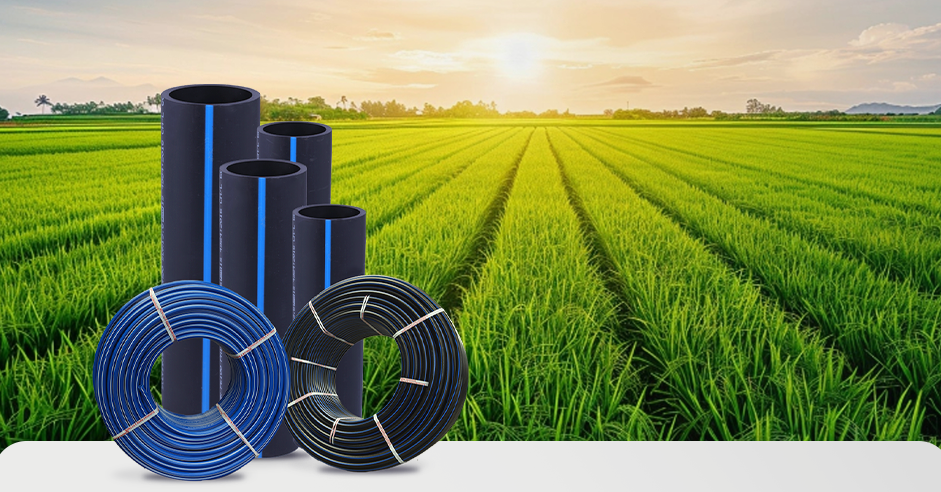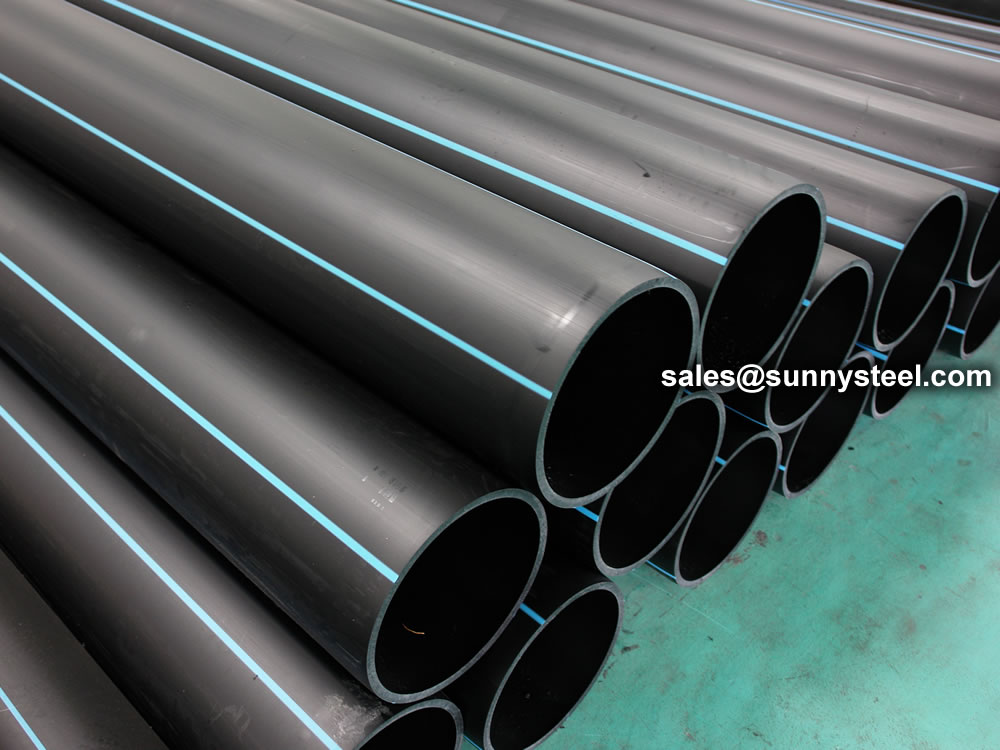Explore the Production Refine Behind High-Quality HDPE Pipeline and Its Applications
The production process of high-quality HDPE pipes is detailed and systematic. It starts with the option of basic materials that enhance efficiency. Following this, ethylene undergoes polymerization to develop material, which is after that shaped with extrusion. Quality assurance is critical, guaranteeing that the end product meets rigid standards. The trip of HDPE pipelines doesn't end with production. Their applications throughout numerous markets expose a more comprehensive significance worth checking out.
Recognizing HDPE: Qualities and Advantages

High-density polyethylene (HDPE) is a functional polycarbonate recognized for its sturdiness and resistance to various ecological factors. This product exhibits superb tensile toughness, making it suitable for requiring applications. Its low-density structure adds to a light-weight product, assisting in convenience of handling and installation. HDPE also showcases amazing resistance to chemicals, which lessens degradation when exposed to harsh substances.
The material's low dampness absorption even more boosts its durability, making it perfect for use in pipelines and tank. In addition, HDPE is resistant to ultraviolet (UV) radiation, ensuring that products keep their integrity even when subjected to sunlight. In addition, its versatility enables for the development of detailed forms without jeopardizing toughness. The green nature of HDPE, commonly stemmed from recycled materials, includes in its appeal, advertising sustainable techniques in production. Overall, these buildings and benefits make HDPE a preferred choice for various commercial and customer applications.
Resources Option for HDPE Production
The selection of basic materials for HDPE production is vital to confirm the end product satisfies the desired requirements and quality requirements. High-density polyethylene (HDPE) is primarily generated from polymerized ethylene, stemmed from nonrenewable fuel sources such as gas or petroleum. The quality of these feedstocks greatly affects the mechanical and thermal residential or commercial properties of the last HDPE.
Additives likewise play a significant duty in improving HDPE's efficiency, including antioxidants, UV stabilizers, and colorants, which boost sturdiness and resistance to environmental factors. The option process need to take into consideration not only the chemical structure of the raw materials yet additionally their processing attributes to guarantee reliable production.
The sourcing of raw materials should prioritize sustainability and conformity with ecological regulations, as liable practices are imperative in today's market. Eventually, cautious raw product option lays the structure for generating high-quality HDPE pipes ideal for varied applications.
The Extrusion Process: Shaping HDPE Pipeline
The extrusion procedure plays a vital duty fit HDPE pipes, beginning with meticulous material preparation methods that assure perfect flow and uniformity. Just as crucial is the design of the die, which straight influences the final dimensions and surface high quality of the pipeline. With each other, these factors contribute substantially to the performance and high quality of HDPE pipeline production.
Product Prep Work Strategies
Effective manufacturing of HDPE pipes starts with meticulous material prep work techniques, particularly the extrusion process. During this stage, high-density polyethylene material is first dried to eliminate dampness, making certain ideal circulation qualities. The material is then fed into the extruder, where it undertakes home heating and melting, transforming into a thick state. This home heating procedure is carefully regulated to keep the product's integrity and efficiency. The molten HDPE is required via a die, shaping it right into a continuous pipe kind. Appropriate temperature administration throughout extrusion is important, as it straight affects the product's buildings and the end product quality. As soon as shaped, the HDPE pipeline is cooled down and reduced to specified lengths, all set for succeeding processing and applications.
Die Design Value
Accuracy in die style plays a necessary function in the extrusion process of HDPE pipes. The die works as the last shaping device, directly affecting the pipe's dimensions, wall thickness, and surface area coating. A properly designed die guarantees consistent product flow, reducing defects such as irregularities and weak spots. The geometry of the die have to be enhanced to accommodate the specific buildings of HDPE, including its viscosity and thermal habits throughout extrusion. In addition, the cooling price of the material as it passes through the die can significantly influence the pipe's structural honesty. Investing in advanced die innovation is important for suppliers aiming to generate high-quality HDPE pipes that meet market standards and consumer assumptions.
Quality Control Actions in HDPE Manufacturing
Although different variables affect the high quality of HDPE pipe manufacturing, effective quality assurance measures are essential to guarantee uniformity and integrity in the last product. Secret high quality control practices consist of extensive material assessment, confirming that the raw polyethylene meets established criteria for pureness and density. Throughout the extrusion procedure, specifications such as temperature, stress, and cooling time are closely kept an eye on to maintain dimensional accuracy and structural stability
On top of that, post-production screening is vital; suppliers often conduct hydrostatic examinations to assess the pipe's stamina and resistance to pressure. Aesthetic assessments for surface area flaws further enhance high quality guarantee. Certification from pertinent requirements organizations, like ASTM or ISO, supplies an added layer of integrity. By applying these extensive quality assurance procedures, makers can decrease problems, enhance efficiency, and make sure that the HDPE pipes fulfill the certain requirements of different applications, inevitably leading to customer complete satisfaction and count on in the item.
Applications of HDPE Pipeline Across Industries
HDPE pipelines are made use of throughout numerous industries as a result of their longevity and versatility. In water circulation systems, they assure effective delivery, while in wastewater monitoring, they give reputable options for waste transportation. Additionally, farming watering networks gain from HDPE's resistance to corrosion and versatility, making it an ideal option for modern-day farming methods.

Water Circulation Systems
A substantial number of markets rely on high-density polyethylene (HDPE) pipelines for efficient water distribution systems. Recognized for their sturdiness and resistance to rust, HDPE pipes are extensively used in local water supply networks, farming watering, and commercial applications. Their lightweight nature facilitates very easy handling and setup, minimizing labor costs and time. Additionally, HDPE pipelines can accommodate different stress degrees, making them appropriate for both reduced and high-pressure systems. Texas hdpe pipe manufacturer. The adaptability of the material enables seamless combination right into existing facilities, decreasing the need for extensive excavation. Furthermore, HDPE's resistance to chemical leaching guarantees that the water delivered stays safe and tidy, making it a suitable option for keeping the quality of potable water throughout numerous markets
Wastewater Monitoring Solutions
Effective water distribution systems likewise lead the way for cutting-edge wastewater administration solutions, where high-density polyethylene (HDPE) pipes play a significant function. Popular for their durability and resistance to rust, HDPE pipelines are optimal for moving wastewater in numerous setups. Their flexibility enables easy installation in intricate environments, minimizing the requirement for extensive excavation. In addition, HDPE's smooth indoor surface minimizes friction, enhancing flow prices and effectiveness. These pipelines are also resistant to chemical leaching, guaranteeing that contaminants do not jeopardize the surrounding environment. Industries, municipalities, and treatment centers increasingly count on HDPE pipes for their reliability and long life, making them a preferred option for modern wastewater monitoring systems. This adaptability underscores the critical importance of HDPE pipes throughout countless applications.
Agricultural Watering Networks
Agricultural watering networks profit considerably from using high-density polyethylene (HDPE) pipelines, which provide effective and dependable water distribution to plants. HDPE pipelines are lightweight, making them simple to transfer and mount, while their adaptability enables different arrangements in varied surfaces. These pipes show exceptional resistance to corrosion, chemicals, and UV radiation, ensuring longevity in severe farming atmospheres. Additionally, their smooth interior surface area decreases rubbing loss, maximizing water circulation and lowering power costs related to pumping. The longevity of HDPE pipelines, usually going beyond half a century, adds to decrease maintenance and substitute costs. Farmers progressively rely on HDPE pipelines to improve watering effectiveness and promote lasting agricultural methods, ultimately leading to improved plant yields and resource preservation.

Future Trends in HDPE Pipe Modern Technology
As the need for lasting and reliable framework grows, improvements in HDPE pipeline modern technology are positioned to change different markets. Emerging trends include the integration of smart technologies, such as sensing units and IoT abilities, which facilitate real-time surveillance of pipe problems, reducing upkeep expenses and avoiding leaks. Furthermore, the growth of innovative manufacturing techniques, such as 3D printing, is making it possible for the manufacturing of facility, customized pipe layouts that deal with certain task needs.
The emphasis on recycling and round economy techniques is driving the innovation of HDPE pipelines made from recycled materials, boosting sustainability. Enhanced jointing approaches, such as electro-fusion and mechanical installations, are likewise improving setup efficiency and dependability. The growing emphasis on environmental guidelines is pushing manufacturers to adopt greener manufacturing procedures, ensuring that HDPE pipelines not only meet market criteria but also promote a more lasting future for facilities advancement.
Often Asked Questions
Just How Does HDPE Compare to Other Plastic Materials?
HDPE outperforms numerous various other plastic products concerning longevity, chemical resistance, and flexibility. Its reduced thickness and high tensile strength make it excellent for numerous applications, typically going beyond choices in both performance and long life.
What Are the Ecological Impacts of HDPE Manufacturing?
The environmental effects of HDPE manufacturing include greenhouse gas exhausts, energy consumption, and possible pollution from making procedures. Additionally, inappropriate disposal can lead to soil and water contamination, increasing issues concerning get more info long-lasting ecological results.
Can HDPE Pipeline Be Recycled?
Yes, HDPE pipelines can be reused. Lots of facilities accept made use of HDPE for handling, transforming it into new items. This reusing adds to sustainability initiatives, reducing plastic waste while preserving resources and energy in the manufacturing cycle.
What Is the Lifespan of HDPE Pipes?

Just How Do Temperature Variations Affect HDPE Pipe Efficiency?
Temperature variations substantially affect HDPE pipeline efficiency, influencing adaptability and stamina. Heats can result in softening, while low temperature levels may trigger brittleness, eventually affecting the pipeline's sturdiness and viability for various applications in varied atmospheres.